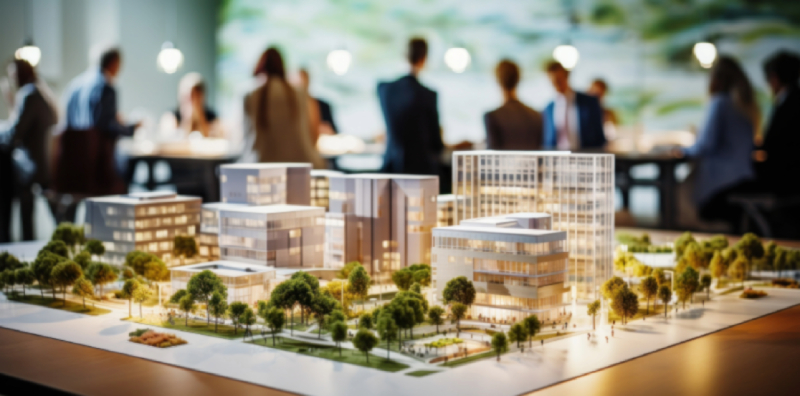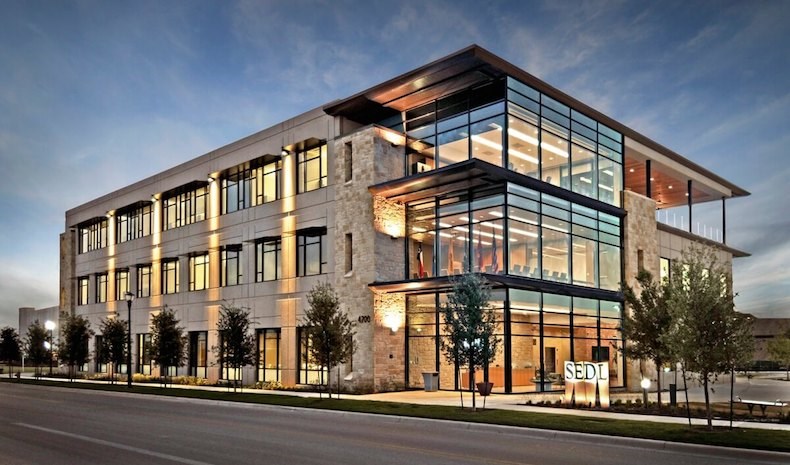Revealing the Comprehensive Solutions Supplied by Commercial Architects for Modern Advancement
Commercial Architects offer an important function in modern advancement projects. They blend design aesthetics with functionality while sticking to regulative requirements. Their experience prolongs past simple building, including lasting techniques and cutting-edge technologies. As they browse complicated zoning laws, Architects collaborate with various stakeholders to bring visions to life. This multifaceted approach raises concerns regarding the progressing role of Architects fit modern areas and the influence of their deal with future advancements.
Recognizing the Duty of Commercial Architects in Modern Dope
In modern city landscapes, Commercial Architects play a vital duty in forming functional and visual rooms that meet varied organization needs. Their competence prolongs beyond plain style; they browse complex zoning legislations, developing codes, and ecological regulations. By working together with customers, they identify details needs, making certain that each job lines up with the client's vision while likewise considering useful facets such as sustainability and cost-effectiveness. Commercial Architects are experienced at integrating cutting-edge modern technologies and products right into their designs, improving both the capability and power performance of buildings. They perform comprehensive site evaluations to evaluate the prospective difficulties and chances offered by an area. In addition, reliable communication with contractors and other stakeholders is essential, making sure that the project progresses smoothly from conception to conclusion. Eventually, Commercial Architects are critical in developing rooms that not only accomplish practical purposes but also add to the general character and vibrancy of metropolitan atmospheres.
Idea Design: Changing Concepts Into Truth
Idea design works as a crucial stage in Commercial design, where ingenious layout solutions arise from imaginative brainstorming. This procedure depends on joint ideation, bringing together diverse perspectives to refine and enhance first concepts. As concepts form, they transform from abstract notions right into concrete architectural facts.
Ingenious Style Solutions
Transforming ideas into reality is the characteristic of ingenious design options in Commercial architecture. These solutions mix imagination with capability, addressing the distinct requirements of modern advancements. By leveraging innovative innovations and lasting practices, Architects craft areas that are not just aesthetically attractive however also effective and versatile. Emphasis on user experience drives the design procedure, ensuring that atmospheres foster efficiency and collaboration. Each task gain from a tailored technique, where concepts are meticulously created to show the client's vision while thinking about future patterns. Ingenious layout services likewise focus on flexibility, permitting modifications in time as service needs develop. Ultimately, these approaches improve the general value of Commercial rooms, making them essential in today's competitive landscape.

Collaborative Ideation Refine
Collaboration serves as the foundation of the ideation process in Commercial style, cultivating creative thinking and innovation amongst diverse stakeholders. Architects, clients, designers, and neighborhood participants take part in vibrant conversations, making sure that all viewpoints are considered. This comprehensive technique enables for the expedition of various style ideas, encouraging one-of-a-kind solutions that line up with the task's vision. With workshops and brainstorming sessions, concepts progress and refine, changing first principles right into concrete layouts. Innovation also plays an essential role, with tools such as Structure Info Modeling (BIM) facilitating real-time collaboration and changes. Eventually, this collective ideation process not only enhances the layout end result however also grows a feeling of ownership and financial investment amongst all celebrations included, leading to effective Commercial advancements.
Zoning Analysis: Navigating Laws and Conformity
As developers begin on new jobs, recognizing zoning regulations is necessary to making certain conformity and avoiding pricey delays. Zoning analysis plays an essential role in this procedure, as it includes examining local zoning legislations that dictate land usage, building height, density, and problems. Commercial Architects possess the competence to browse these intricate guidelines, helping customers recognize permissible usages and any type of necessary variances.
Sustainable Style Practices: Structure for the Future
Lasting design practices are increasingly necessary in the domain of Commercial design, specifically as ecological issues continue to intensify. Architects focus on environmentally friendly products, energy-efficient systems, and style techniques that decrease waste and ecological influence. Including eco-friendly energy sources, such as photovoltaic panels and wind turbines, permits buildings to generate their very own power and minimize dependence on fossil fuels.Furthermore, lasting design stresses the significance of interior environmental top quality. This consists of utilizing natural light, enhancing ventilation, and selecting non-toxic materials to boost owner health and wellness and performance. Eco-friendly roofs and living wall surfaces are likewise popular attributes official statement that contribute to biodiversity and metropolitan cooling.Additionally, Commercial Architects typically integrate water preservation techniques, like rainwater harvesting and drought-resistant landscape design. Via these ingenious techniques, they produce areas that not only meet contemporary needs but likewise foster a sustainable future, addressing the expanding demand for liable development in the contemporary globe.
Project Management: Ensuring Timely and Reliable Execution
Reliable job administration is necessary for making sure that Commercial design tasks are completed promptly and within budget plan. This role encompasses a range of obligations, consisting of the sychronisation of various stakeholders, timelines, and resources. Commercial Architects take advantage of their competence to create comprehensive project plans that detail crucial milestones and deliverables, allowing for methodical progress tracking.Regular communication amongst employee and customers is crucial, fostering transparency and assisting in timely decision-making. Danger management techniques are additionally used to recognize prospective challenges early, allowing proactive remedies to be established. By using sophisticated job management devices, Architects can monitor task performance in real-time, making modifications as necessary to maintain effectiveness.
Interior Decoration: Creating Useful and Aesthetic Rooms
Interior decoration plays a vital role in enhancing both functionality and looks within Commercial rooms. Effective area planning can enhance workflow and enhance customer experience, while aesthetic layout principles add to an aesthetically appealing environment - commercial architects. With each other, these components create spaces that are not just practical but likewise motivating
Space Planning Effectiveness
While maximizing the energy of available room, Commercial Architects prioritize room preparation performance to produce both practical and aesthetically pleasing atmospheres. This approach involves mindful analysis of the spatial design to ensure optimal use of every square foot. Architects think about elements such as operations, accessibility, and natural light to boost use. By purposefully putting furniture, tools, and workstations, they help with activity and interaction amongst individuals, promoting efficiency. Additionally, zoning different locations for certain features helps in handling sound and privacy, developing an unified atmosphere. Through efficient room planning, Commercial Architects can transform restraints right into opportunities, guaranteeing that each area satisfies the varied needs of its occupants while adhering to regulative demands and sector criteria.
Aesthetic Style Principles
Aesthetic style principles have a peek at this website play a vital function fit environments that are not just useful however additionally aesthetically appealing. These concepts direct Commercial Architects in developing spaces that reverberate with customers while boosting brand identity. Crucial element consist of balance, proportion, and harmony, which work with each other to develop a natural appearance. Color pattern and materials are carefully picked to stimulate preferred emotions and support the general motif. Additionally, lighting plays an important function, influencing state of mind and presence while highlighting building functions. By incorporating these concepts, Architects assure that rooms are not only sensible but additionally welcoming and motivating. Inevitably, reliable aesthetic style cultivates a positive individual experience, urging engagement and contentment in Commercial environments.
Collaboration With Stakeholders: Fostering Successful Collaborations
Successful collaborations in Commercial style depend upon efficient collaboration with stakeholders, ensuring that every voice is listened to and valued. This collective approach includes interesting different events, including customers, professionals, and community members, throughout the layout and advancement procedure. By fostering open interaction, Commercial Architects can attend to concerns, collect insights, and straighten the project's vision with stakeholder expectations.The combination of varied perspectives boosts imagination and technology, bring about even more useful and cosmetically pleasing designs. Routine conferences, feedback sessions, and workshops facilitate this dialogue, enabling Architects to adjust their strategies in reaction to stakeholder input. Furthermore, establishing trust through openness and accountability reinforces these partnerships, resulting in a smoother job execution.Ultimately, the success of modern-day developments depends upon the Architects' ability to navigate and harmonize varying interests, developing a collaborative setting that promotes common objectives and mutual success.
Regularly Asked Concerns
Just How Do Commercial Architects Deal With Budget Plan Constraints During a Task?

What Kinds of Software Program Do Commercial Architects Typically Utilize?
Commercial Architects typically make use of software application such as AutoCAD for composing, Revit for Building Information Modeling, SketchUp for 3D modeling, and project administration devices like Microsoft Job to improve collaboration and improve operations throughout the layout process.
Can Commercial Architects Aid With Getting Financing for Projects?
Commercial Architects can help in acquiring financing for tasks resource by preparing thorough proposals, assisting to express design visions, and supplying monetary forecasts that can boost the possibility of protecting needed financing from capitalists or banks.
How Do Architects Make Certain Safety And Security During the Construction Process?
Architects guarantee safety during building by implementing rigorous style criteria, collaborating with engineers, carrying out routine website evaluations, adhering to local regulations, and fostering interaction among all stakeholders to reduce risks and advertise a safe working setting.
What Continuous Assistance Do Architects Offer After Job Conclusion?
After task completion, Architects provide ongoing support through maintenance appointments, efficiency assessments, and design alterations. They assure structures meet progressing needs, address prospective concerns, and maintain conformity with regulations, promoting a long-term partnership with clients.